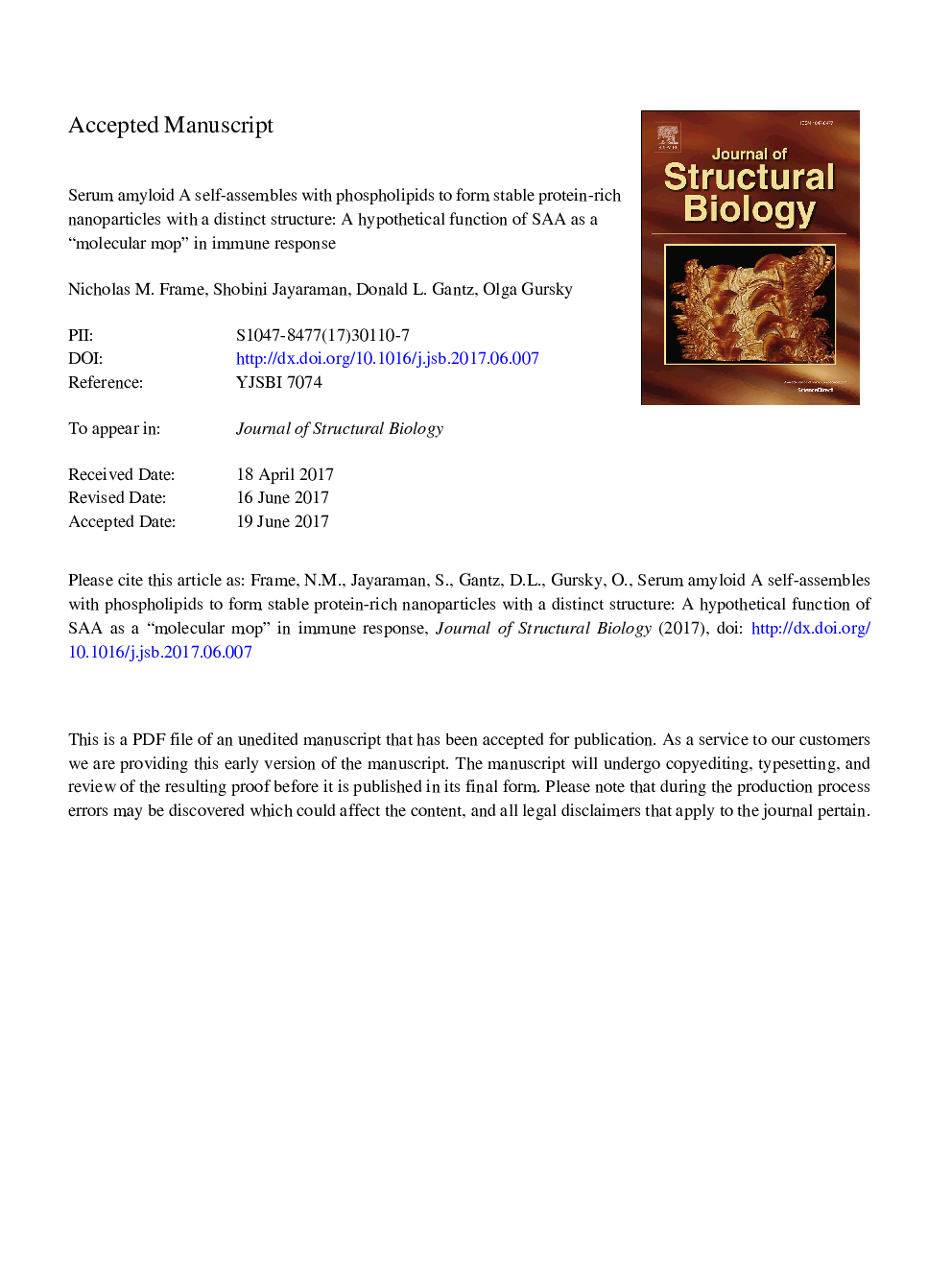| کد مقاله | کد نشریه | سال انتشار | مقاله انگلیسی | نسخه تمام متن |
|---|---|---|---|---|
| 8648288 | 1570443 | 2017 | 33 صفحه PDF | دانلود رایگان |
عنوان انگلیسی مقاله ISI
Serum amyloid A self-assembles with phospholipids to form stable protein-rich nanoparticles with a distinct structure: A hypothetical function of SAA as a “molecular mop” in immune response
دانلود مقاله + سفارش ترجمه
دانلود مقاله ISI انگلیسی
رایگان برای ایرانیان
کلمات کلیدی
ABCSECPoPCHDLApoA-IPAGESAA1-Palmitoyl-2-oleoyl-sn-glycero-3-phosphocholine - 1-پالمیتویل-2-اولئویل-اسن-گلیسرو-3-فسفوشولینhigh-density lipoprotein - HDL یا لیپوپروتئین با دانسیته بالا یا چگالی بالاamyloid A - آمیلوئید AApolipoprotein A-I - آپولیپوپروتئین A-Ipolyacrylamide gel electrophoresis - الکتروفورز ژل پلی آکریل آمیدSize-exclusion chromatography - اندازه گیری کروماتوگرافی حذف شدهcircular dichroism - رنگ تابی دورانیserum amyloid A - سرم آمیلوئید Aphosphatidylcholine - فسفاتیدیل کولینSUV - ماشین شاسی بلندElectron microscopy - میکروسکوپ الکترونیATP-binding cassette - کیت اتصال به ATPsmall unilamellar vesicles - کیسه های کوچک کوچک
موضوعات مرتبط
علوم زیستی و بیوفناوری
بیوشیمی، ژنتیک و زیست شناسی مولکولی
زیست شناسی مولکولی
پیش نمایش صفحه اول مقاله

چکیده انگلیسی
Serum amyloid A (SAA) is an acute-phase protein whose action in innate immunity and lipid homeostasis is unclear. Most circulating SAA binds plasma high-density lipoproteins (HDL) and reroutes lipid transport. In vivo SAA binds existing lipoproteins or generates them de novo upon lipid uptake from cells. We explored the products of SAA-lipid interactions and lipoprotein remodeling in vitro. SAA complexes with palmitoyl-oleoyl phosphocholine (POPC) were analyzed for structure and stability using circular dichroism and fluorescence spectroscopy, electron microscopy, gel electrophoresis and gel filtration. The results revealed the formation of 8-11 nm lipoproteins that were â¼50% α-helical and stable at near-physiological conditions but were irreversibly remodeled at Tm â¼Â 52 °C. Similar HDL-size nanoparticles formed spontaneously at ambient conditions or upon thermal remodeling of parent lipoproteins containing various amounts of proteins and lipids, including POPC and cholesterol. Therefore, such HDL-size particles formed stable kinetically accessible structures in a wide range of conditions. Based on their size and stoichiometry, each particle contained about 12 SAA and 72 POPC molecules, with a protein:lipid weight ratio circa 2.5:1, suggesting a structure distinct from HDL. High stability of these nanoparticles and their HDL-like size suggest that similar lipoproteins may form in vivo during inflammation or injury when SAA concentration is high and membranes from dead cells require rapid removal. We speculate that solubilization of membranes by SAA to generate lipoproteins in a spontaneous energy-independent process constitutes the primordial function of this ancient protein, providing the first line of defense in clearing cell debris from the injured sites.
ناشر
Database: Elsevier - ScienceDirect (ساینس دایرکت)
Journal: Journal of Structural Biology - Volume 200, Issue 3, December 2017, Pages 293-302
Journal: Journal of Structural Biology - Volume 200, Issue 3, December 2017, Pages 293-302
نویسندگان
Nicholas M. Frame, Shobini Jayaraman, Donald L. Gantz, Olga Gursky,